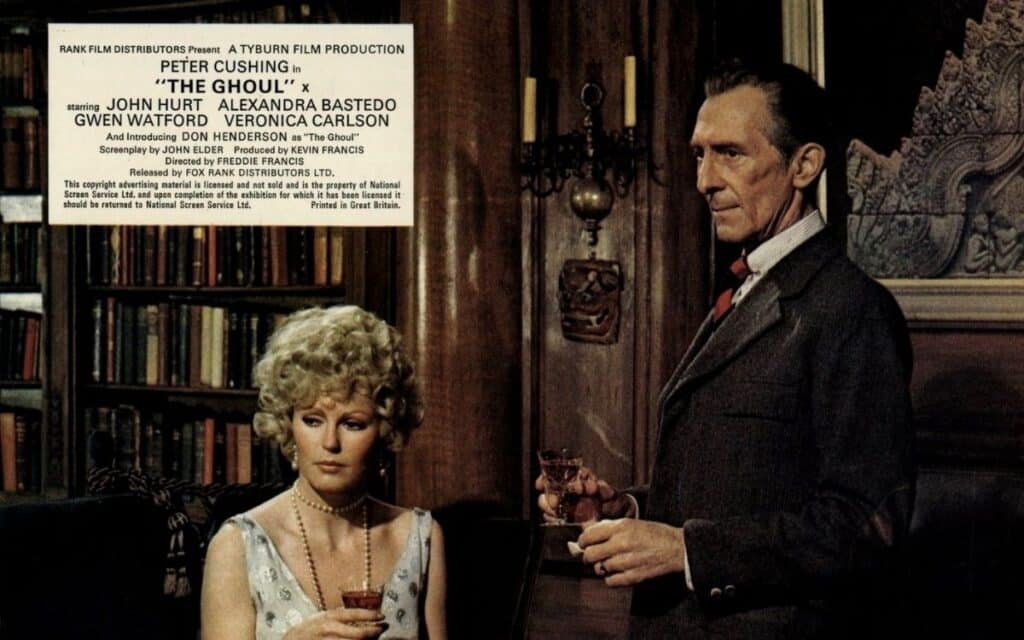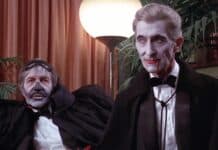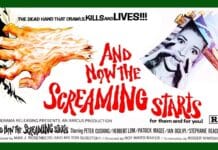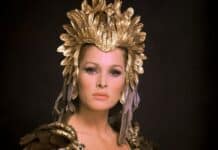The Ghoul 1975 is a vintage British horror of contradictions and worth seeing for the fine performances of its cast, including Peter Cushing and Veronica Carlson, says TERRY SHERWOOD

TITLE: The Ghoul
YEAR RELEASED: 1975
DIRECTOR: Freddie Francis
CAST: Peter Cushing, John Hurt, Alexandra Bastedo, Veronica Carlson, Gwen Watford, Don Henderson, Ian McCulloch, Stewart Bevan, John D. Collins,Dan Meaden
The Ghoul 1975 Review
Britain in the Twenties were heady days for some. The young ones discovered a new world of parties and hedonism as depicted in the opening scenes of The Ghoul 1975.
Freddie Francis, who was at the helm of Hammer’s successful if not controversial, Dracula Has Risen from the Grave 1968 and a personal favourite The Evil of Frankenstein 1964, switched over to Tyburn to direct The Ghoul 1975.
The Ghoul 1975 was preceded by the Freddie Francis-directed Tales that Witness Madness 1973, which was an imitation of the Amicus portmanteau films. Hammer Studios was stumbling, trying to find its market again in changing genre landscape so naturally, their formula was being imitated with varied results. Tyburn wanted to make a more realistic film in an attempt to be the ‘New Hammer”. Budget naturally played a role in this with the compressed shooting schedule making The Ghoul 1975 an interesting artefact.
Twenty Three Ski-Doo
The Ghoul 1975 has an impressive cast for the time of Peter Cushing, John Hurt, Alexandra Bastedo, and Veronica Carlson, with support from Gwen Watford, Don Henderson, and others. The film was shot at Pinewood Studios with location work in Buckinghamshire and Iver Heath as perhaps Hammer filming in some impressive gothic locales.
The film opens with a sort of prologue that appears to have been tacked on of Daphne Wells Hunter (Veronica Carlson) walking the dark corridors of a ghostly house. She moves and is startled by a whispering voice only to have it actually be a party prank set up by her friends. The party starts and it is revealed that the film is set in the 1920s, with champagne flowing.
Honestly, it took this viewer a while to place the time period till the music and dancing. There’s lovely attention to fashion, however, if you forget some of the obvious wigs and seventies hairstyles on the men, the scene works. Missing, and this is a glaring point of the whole film, is the language of the 1920s, which was more evident in the Hollywood films of that era.
It’s The Cat’s Meow
It was the age of silliness like cramming people into a phone booth, eating live goldfish so, in this picture we get, two men Geoffrey (Ian McCulloch) and Billy (Stewart Bevan) after bragging about each other’s cars decide to stage a race in their cars from the party mansion to Landed End, 200 miles away.
The race is instigated by Daphne and Angela (Alexander Bastedo) who are eager for the crazy challenge as Daphne insists on driving Billy’s more powerful car. The race begins with a series of nocturnal spins around corners and process shots for the time. The race ends prematurely as one of the cars comes to a halt in thick fog on the moors, with Daphne and Billy running out of petrol because he didn’t check it.
Billy moves off to find a garage and comes upon Tom (John Hurt), with Daphne fleeing into the arms of Dr. Lawrence,(Peter Cushing) a former missionary now living in a huge mansion on the misty moors. This moment is shot the same way echoing back to the sudden introduction of Baron Frankenstein in the Freddie Francis directed Evil of Frankenstein 1964.
Daphne comes to the conclusion that all is not quite right with the Doctor as she learns Lawrence has a son that he likes to keep locked up in the mansion that was corrupted by Indians while he worked as a missionary. That same son now has a taste for human flesh.
The dialogue between Cushing and Carlson is direct and tasteful for the time with some audiences today perhaps finding the pacing, not to their liking.
Particularly sensitive are the moments when Cushing’s character reveals the pain of his wife’s suicide punctuated by the real photography on the mantle of his actual newly-deceased real-life wife, that Peter so desperately loved.
The Too Real McCoy
A line of demarcation occurs in The Ghoul 1975 influenced by many contemporary filmmakers such as Pete Walker who was enjoying success, particularly with the younger market and others. These filmmakers mixed often sadistic, sexually charged violence with sawed-off limbs and plenty of screams.
This film doesn’t go that far so suffice it to say that Daphne is killed and dismembered expertly by Dr. Lawrence’s Indian servant played by Gwen Watford) You do not see this on-screen yet it is implied with detail mostly credit to Watford’s cold-blooded expression and singing voice throughout. One gets the idea quite well as she slowly makes her way up the steps to the captive son’s room with a metal pot that is grabbed by a monstrous hand and pulled in.
The story then becomes one of Geoffrey trying to find the missing friends when Angela disappears. The film takes a dark turn yet craftily not being graphic as you have inserted scenes of Peter Cushing going through terrible anguish in the mansions altar. This was undoubtedly real as the actor was told to do certain scenes multiple times resulting in real memories of his wife.
John Hurt takes a turn as Tom Rawlings who works on the estate and particulates in the murders. In another influenced scene Rawling viciously slaps both Angela and Daphne in spate scenes demanding that they be nice to him. He also threatens to assault both women, particularly Angela. There are stage slaps and there are these slaps that are different bordering on sadistic as they occur suddenly and painfully again influenced by the perceived new realism of the horror genre and a cross over to exploitation.
Nerts To You
Some other reviewers have made remarks as to the apparent colonialism in the film as references by the Indian people being the cause of the son’s taste for human flesh. The evil foreigner corrupts the unexpected with its pagan religion.
This is a film of its time and the characters of a time when the British rule and presence in India occurred. My question to those that find it offensive is if you do find the colonialism aspect repugnant, how do you stand on the eating of human flesh?
This film would not be acceptable today for a different reason of having a Caucasian portray a person of Indian descent, even though that was a fact of industry at the time.
The Ghoul 1975 is a film with a mixed angle of the story. One can see the hard influences coming out of the violence and what was to come in the genre perhaps making that the good old naïve days of horror are over.
The picture features fine performances by Peter Cushing, who was labouring under real sadness and memory to deliver moments of real poignancy. It is also one of the finest roles of Veronica Carlson as she gets to say words, not be window dressing.
This film is worth a look for its contradictions and performances of Cushing and the late Veronica Carlson.
Have you seen The Ghoul 1975? Tell us your thoughts in the comments section!








One of those films that’d make a real killing on dvd/blu ray etc, if someone released it in the proper form. Are there a number of reasons it remains so unattainable?
Great review of one of my favourite horror films of all time.
I believe Peter Cushings finest performance.
This film has so much atmpsphere and great characters portrayed by fine actors.
If i had one criticism it would be that the actual ghoul we see could have looked more frightening…but then the Ghoul wouldn’t be the Ghoul!